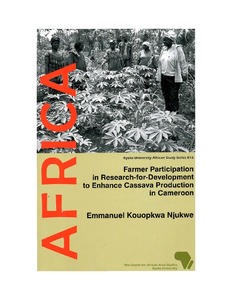| dc.description.abstract | Cassava (Manihot esculenta Crantz) is a staple food crop in Cameroon and cultivated mainly for its starchy roots consumed raw, boiled or processed, but also for its leaves which serve as vegetable. Despite its importance, the yield gap is often large due to many challenges that include low soil fertility and the use of traditional production techniques while local varieties are susceptible to pests and diseases. To overcome these challenges, there have been efforts to introduce and evaluate several cassava varieties since the early 1980s for root yield and other agronomic characteristics, to identify high-yielding varieties for dissemination. A few of the promising varieties were tested with farmers in collaboration with extension officers, but adoption was not successful, mainly because farmers were not involved in the selection process prior to dissemination.
In 2001, 290 cassava clones were brought to Cameroon from IITA Ibadan, Nigeria, and evaluated in on-station and in on-farm, participatory trials. A socio-economic study was carried out to learn farmer criteria for cassava variety preference. (On-station evaluation was conducted in Mbalmayo between 2001 and 2004) In 2004 eleven varieties were selected from the initial several hundred for their agronomic characteristics as well as pest and disease resistance. Prior to on-farm testing, farmers in Mbalmayo visited the on-station trial at the vegetative and harvest stages for further selection of varieties manageable under farm conditions. Of the eleven, 6 varieties (8085, 88071-3, 92/0057, 92/0326, 96/0023 and 96/1414) were retained, based on yield performance, disease resistance and growth characteristics.
On-farm participatory evaluation was conducted in 2004 and 2005 with 30 farmers and in five regions in 2006, where farmers evaluated the six improved varieties. Sensory quality data was successfully collected from all trials. Analysis of agronomic and sensory data showed that farmers generally preferred high yield, good mealiness, pest and disease resistance, early-maturity and ease in peeling, but regional preference varied for the branching habit, plant height, leafiness/plant canopy cover, long stem storage and root storage quality. These criteria in farmer preference were incorporated into the selection process to facilitate the policy dimension toward the official release of 5 varieties (92/0326, 92/0057, 96/0023, 96/1414 and 92/0067) and for their qualities and suitability in controlling cassava green mites. This selective process showed that future cassava evaluation could accelerate with farmer involvement at the earlier stages of varietal selection.
To meet with the increased productivity of improved varieties, 80 manual and 20 motorized cassava chippers were improved and manufactured locally, tested with farmers, and delivered to about 1500 farmers in 35 villages in 10 regions of Cameroon. The chippers were made with locally available, low cost material, easy to repair/clean, manually driven with no additional fuel cost, mobile, and easy to carry and share with other farmers in rural and inaccessible areas without electricity. Because of the smallholder nature of farming systems and the low farmer density in more inaccessible areas, investment in immobile and motorized cassava processing equipment is often not economically justified by the production capacity in many areas of Cameroon.
Despite these initiatives, full development of the cassava sector faced several challenges, such as poor organization and planning, limited access to credit and the market, and high transportation and transaction costs. To address these shortcomings, value chain approach was adopted that guarantees the coverage of production to consumption and considers all groups from farmers to consumers, including traders, transporters and processors and developed a variety of cassava processing techniques to broaden the range of products derived from cassava. Stakeholders’ platform was instituted as a mechanism for appropriate knowledge sharing so that smallholder farmers learned to organize themselves and work as legitimate groups and operate independently.
A case study in Mbouda indicates that before year 2000, cassava marketing was on individual basis and dominated by traders from Central Africa Republic (CAR), Gabon and Congo Brazzaville. Supply was insufficient and irregular while quality was poor, coupled with irregular payment and varying prices as well as high transportation costs. In this study, group marketing was promoted and linkages among actors, and a women’s group were initiated in Mbouda by 10 female traders, and collection points were set up in neighboring villages. Cassava chips from retailers were sorted, graded and milled in a warehouse for export to Libreville and Port Gentile in Gabon and Congo Brazzaville with a small portion for domestic markets. Farmers were encouraged to work in co-operatives, and to set a minimum selling price to limit unfair competition between them, and to avoid being cheated by other producers and traders.
The future of cassava in Cameroon is bright, but depends very much upon development of improved products to meet the expectations of producers, transporters and consumers and on its suitability for alternative uses. There is also need to build producer capacity for commercial farming designed to explore market opportunities, but there is no need to spend resources on improving production on the farm if the transportation of the product is expensive or the processing and marketing are inefficient. |

